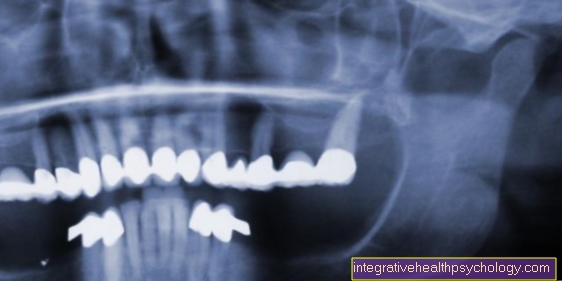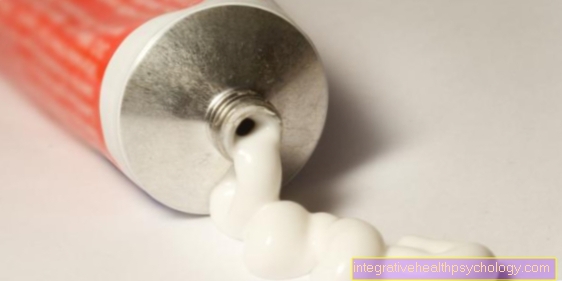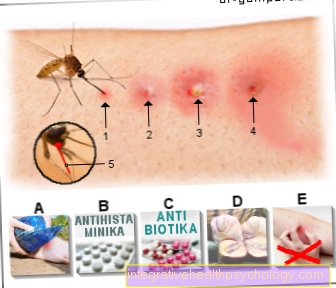Laboratory examination of the blood
introduction
The blood test is a frequently used method, both in clinics and in doctor's offices. It provides information about the function of our organs, about enzymes that are important for our metabolism, about the clotting of our blood (see also: Blood clotting) and much more.
Various parameters are then examined in the blood. Each of these parameters can provide information about a possible disease. In the case of diabetics, for example, daily blood monitoring is important in order to keep the blood sugar level constant. Even a tiny drop of blood can tell a diabetic how much insulin they need. The blood test is therefore also used to monitor health.
Depending on what is being examined, the patient should be sober, which means that he is not allowed to drink or eat anything. This is especially important when examining blood sugar levels.
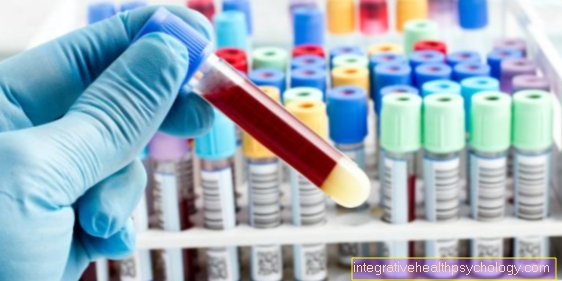
Diagnosis / procedure
In order to be able to make a diagnosis, the patient is first given a Cannula or a so-called Butterflies venous blood taken. The most common removal location is Elbow bendbecause there is a vein here (Vena mediana cubiti) is very superficial and therefore easy to find in most patients. The patient is given a Cuff on the upper arm created that is drawn. This causes the blood to build up in the vein and the vein emerges even better. Depending on the blood test, this is usually enough 2 ml of venous blood out. Many parameters can be tested with one sample, but for some tests it is useful to take multiple blood samples for better accuracy. In some patients, the vein in the elbow area may not be clearly visible and difficult to find. Here it makes sense, either at one Hand vein To draw blood or a Foot vein, because these are also more superficial. In general, blood can be drawn from any superficial vein.
With the removed blood it is always about Whole blood, that means that all substances are still in the blood, such as Clotting factors. With this whole blood you can, for example, use the PH value of the blood or the Blood sugar concentration.
These are to be distinguished from whole blood Blood plasma as well as that Blood serum, which play a crucial role, especially when donating blood.
In order to obtain blood plasma, one must have whole blood EDTA (Ethylenediaminetetraacetic acid), Sodium citrate or Heparin Add. These prevent the blood from clotting. By centrifuging the whole blood now, blood plasma is obtained. This blood plasma consists of the non-cellular part of whole blood. 90% is water here. The remaining 10% included Electrolytes (Sodium, potassium ...), hormones, proteins, nutrients and breakdown products. In order to obtain blood serum, the coagulation is allowed to take place. A solid, clumped part, the blood thrombus, and a yellow, clear liquid are formed. This yellow liquid is the blood serum and its composition corresponds to the plasma, only it does not contain any fibrinogen (a protein complex that ensures that the wound is primarily closed with a kind of blood crust during wound healing).
The blood test is therefore always an examination of the whole blood, which still contains all of the components. A distinction is made between different procedures for the blood test. Establishing what is known as a disease is very important for diagnosing a disease Blood count. A distinction is made between 2 forms: The so-called Small blood count and the Differential blood count. Both together are referred to as Complete blood count.
The small blood count
This is often used for blood tests small blood count. One usually uses for this EDTA blood. EDTA (Ethylenediaminetetraacetic acid) is a so-called complexing agent. This means that EDTA can bind calcium ions and form complexes with them. These Ca2 + ions are now missing in the blood clotting, consequently the blood clotting cannot take place and that Blood stays fluid.
With a small blood count you examine them cellular components. Normally a man's blood contains around 43-50% cellular components, a woman's blood only around 37-45%. This cellular component in the total blood volume is called Hematocrit designated. The hematocrit can decrease sharply, especially during pregnancy. The hematocrit is primarily dependent on the red blood cells, the Erythrocytes, as these are the most common in terms of quantity. In women, 4.3-5.2 million erythrocytes are found per ul of blood; in men 4.8-5.2 million. Erythrocytes serve that Oxygen transport in the body and ensure that the oxygen absorbed by the lung from being brought out into the whole body and to all organs. It comes to Lack of oxygen, to constant stress or to dehydration (e.g. from drinking too little), the number of erythrocytes in the blood is increased. At Blood loss or at Iron deficiency there is a reduced number of erythrocytes in the blood. In addition to the erythrocytes, the number of reticulocytes can also be determined. Reticulocytes are the precursors to erythrocytes. Usually, the blood test will only find a few, but one will come up increased formation of new blood (for example after severe blood loss), they can be found in increased numbers in the blood.
Next will be the white blood cellswho have favourited white blood cells. A total of 4-10 thousand leukocytes are found per ul of blood. With the leukocytes one differentiates between Lymphocytes, Monocytes and 3 types of granulocytes. These are determined more precisely in the differential blood count and are not part of the examination of the small blood count. Since leukocytes for example allergic reactions play an important role, they are found after an allergic attack, but also after Inflammation or after one Attack of gout increased in the blood. Especially in white blood cancer (leukemia) their number increases enormously. After a virus infection, such as the flu, the values can be lowered.
Also taken into account in the blood test are the Platelets (Platelets), of which 150-400 thousand are found per ul of blood. These serve the Blood clotting. Our blood does not contain enough Platelets, one speaks of thrombocytopenia. The blood clotting cannot proceed properly and a increased tendency to bleed. However, thrombocytopathy can also occur. The bleeding time is also prolonged in this case despite the normal number of platelets. Since this, however not fully functional there is a longer bleeding time and small punctiform skin hemorrhages (so-called petechiae). To test whether the number or shape of platelets is normal, the mean platelet volume is used in the blood test.
Other parameters that are considered in the blood test of the small blood count are the red blood pigment (hemoglobin), which binds the oxygen. An Hb value of 12-16 g / dl is normal for women; for men, the Hb value should be in the range of 14-18 g / l. Of the MCH (mean corpuscular hemoglobin), of the MCV (mean corpuscular volume) and the MCHC (mean corpuscular hamoglobin concentration) can only be determined by calculations and provide information about the properties of the red blood cells (erythorocytes). The information serves as differential diagnosis in the event of a Anemia (anemia).
The differential blood count

A blood test can also be a Differential blood count to be created. Together with the small blood count, both are referred to as the complete blood count. One also uses it for the differential blood count EDTA blood or blood drawn through a small capillary. This capillary blood can, for example, from the Fingertip originate and, in contrast to whole blood, is not purely venous blood but contains certain substances (e.g. glucose) in increased concentrations.
The blood is now based on the specific forms of the white blood cells (Leukocytes) examined. One differentiates among the leukocytes, on the one hand, the lymphocytes, which are the specific immune defense serve; Monocytes, which are used for general immune defense, and granulocytes. When it comes to granulocytes, a distinction is made between neutrophilic, eosinophilic and basophilic granulocytes.
The neutrophil granulocytes serve the unspecific defense against, for example bacteria. One can distinguish between the rod-like and segmented neutrophilic granulocytes, which, however, do not differ in their function. A total of 3000-6000 neutrophils per ul of blood should be found in this blood test.
The eosinophils are for the allergic reaction responsible and can against Parasite infestation (e.g. a worm infection) proceed. Approximately 50-250 eosinophilic granulocytes should be found per ul of blood.
The basophilic granulocytes also serve the allergic reaction. Only about 15-50 basophilic granulocytes are found per ul of blood.
A differential blood count is not a typical blood test and is only done if a severe infection, a parasite disease (Parasitemia; for example at malaria) or one Blood disease such as leukemia (blood cancer). After a parasite infestation, it can be seen that the number of eosinophilic granulocytes is greatly increased. If, on the other hand, the values of the monocytes are increased, this can indicate tuberculosis disease. After an infection with the HI virus (HIV) the number of lymphocytes is reduced (lymphocytopenia).
In the blood test of the small blood count and the differential blood count, the values of the individual cells are given in a reference range. The values of a healthy patient should be in this range. Nevertheless, it is said that, by definition, every 20th value should be outside of normal values. If there are slight deviations, this does not have to be an indication of an illness.
Another blood test
In addition to the complete blood count, the blood is examined in other ways and for other indicators. The blood test can also provide information about the Electrolyte balance give. The blood is examined in the laboratory and it is determined whether Sodium, chloride, potassium, calcium and other electrolytes present in healthy concentration or whether there is a deficiency or an excess of a certain electrolyte. The importance of electrolytes in one is particularly clear Leg cramp: There too little magnesium circulates in the blood, there is a painful twitch of the muscle. The electrolytes have a wide variety of functions and therefore it is important to keep the concentrations as constant as possible. For example, if the blood test reveals an increased concentration of potassium in the blood, this may be the reason for Cardiac arrhythmias be.
Please also read our page Electrolytes in the blood.
Another blood test is the so-called coagulation test. One differentiates here Quick test and the PTT (partial thromboplastin time). If these tests are prolonged, this indicates a disturbed coagulation. A prominent example is that Hemophilia A. or B.where coagulation factors do not work properly for genetic reasons. As a result, the clotting does not proceed quickly enough and affected patients bleed for a long time. With such a hemophilia the PTT in particular would be prolonged.
The blood test can also examine the liver, kidney and heart values. Even during an examination Viruses (such as HIV) or for a possible inflammation one uses the blood test. The blood test can also provide information about the hormone activity.
costs
The costs of a blood test vary depending on whether you are privately insured or with a statutory health insurance company.
Statutory health insurance pays for a blood test every two years if the patient is over 35 years old. However, if the attending physician considers it useful, such a blood test can be carried out more often.
If a patient would like to have a test carried out without complaints, the costs for the blood test vary depending on the doctor and the responsible laboratory 80-200 €. However, there are also values that health insurance companies do not adopt. These include, for example, the cost of blood tests from PSA and testosterone.
With the help of the PSA test one examines specific prostate antigens, the indication of a possible Prostate cancer should give. However, since the examination as early cancer detection is controversial and there is no agreement as to whether the test can provide information on early detection, the health insurance companies do not pay for this test. The cost of this blood test adds up to 15-45 €. The cost of this blood test can also increase when testing the testosterone level in the blood up to € 80 amount.







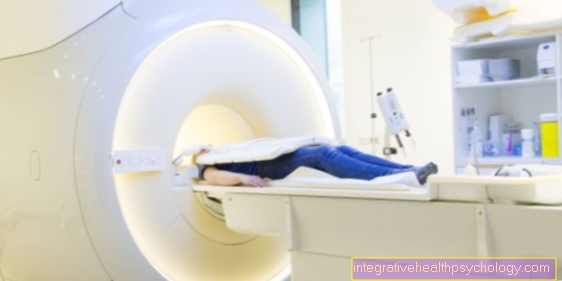
.jpg)


